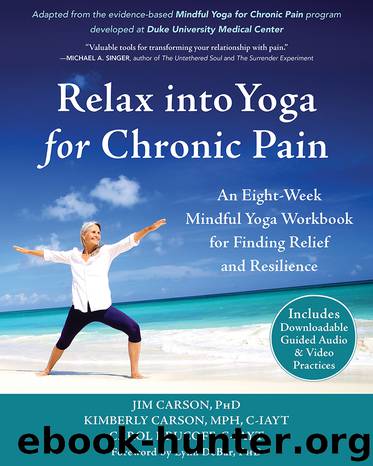Relax into Yoga for Chronic Pain by Jim Carson

Author:Jim Carson
Language: eng
Format: epub
Tags: relax into yoga;yoga for chronic pain
Publisher: New Harbinger Publications
Published: 2019-12-03T17:41:39+00:00
How Pain Works
For centuries, pain was thought to function almost exclusively as a warning signal of physical injury. In the early 1600s, the French philosopher and scientist René Descartes studied human cadavers and theorized that, when a body part was injured, a signal traveled from the site of the injury to the brain, which would then command an appropriate action.
For example, if your finger was caught in a mouse trap, this would trigger an alarm signal from your finger to your brain, which would cause you to free your finger from the trap. This model assumed that specialized nerves, spread throughout the body, pick up pain signals and transmit them to the brain via the spinal cord. The signals were thought to travel just one way—from the injury to the brain. And the strength of the signals was thought to indicate the severity of injury, that is, stronger pain meant greater injury.
Many people, including some doctors, still think of pain in this way. Yet scientists began questioning this simplistic explanation in the mid-1900s because common battlefield situations during World War II defied this one-dimensional understanding of pain. For instance, military doctors noted that right after being seriously injured in combat, many soldiers felt little or no pain. This contradicted the way pain was thought to work. In contrast, soldiers who had a limb amputated nearly always continued to feel excruciating “phantom pain” that seemed to come from the limb that was no longer there—which makes no sense if pain is simply a signal transmitted from an injured body part.
Gate Control Model
To make sense of these unexpected situations, scientists developed a new theory for how pain works. First proposed in the mid-1960s, the gate control model hypothesized that there is a biochemical gateway located where nerves from various parts of the body connect to the spinal cord. When this gate is more fully open, pain signals pass more freely to the brain, so the person feels pain more intensely. When the gate closes substantially, signals can’t pass as easily, so the person feels pain less intensely. Further, these scientists theorized that the opening and closing of this biochemical gate is influenced by a variety of factors, including a person’s thoughts and emotions.
Download
This site does not store any files on its server. We only index and link to content provided by other sites. Please contact the content providers to delete copyright contents if any and email us, we'll remove relevant links or contents immediately.
Men In Love by Nancy Friday(4378)
Everything Happens for a Reason by Kate Bowler(4088)
The Immortal Life of Henrietta Lacks by Rebecca Skloot(3853)
Why We Sleep by Matthew Walker(3808)
The Sports Rules Book by Human Kinetics(3625)
Not a Diet Book by James Smith(2766)
The Emperor of All Maladies: A Biography of Cancer by Siddhartha Mukherjee(2455)
Sapiens and Homo Deus by Yuval Noah Harari(2443)
Day by Elie Wiesel(2265)
Endless Forms Most Beautiful by Sean B. Carroll(2102)
Angels in America by Tony Kushner(2067)
A Burst of Light by Audre Lorde(1996)
Hashimoto's Protocol by Izabella Wentz PharmD(1916)
Dirty Genes by Ben Lynch(1877)
Reservoir 13 by Jon McGregor(1870)
Stretching to Stay Young by Jessica Matthews(1730)
The Immune System Recovery Plan by Susan Blum(1714)
Fat for Fuel by Joseph Mercola(1713)
Boost Your Brain Power in 60 Seconds by Michelle Schoffro Cook(1691)
